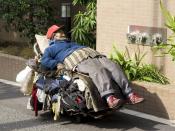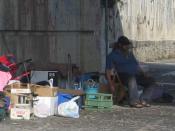A person is defined as being homeless when he/she lacks a fixed nightime
shelter. Therefore, we must rethink our views on whom we regard as
homeless. On any given night 760,000 men, woman and children, have no
control over where they sleep, eat or go to the bathroom, which are all
vital daily human needs which we all appear to take for granted.
Homelessness is certainly not defined by those living in boxes, under
bridges or at subway gates. Homelessness is defined by a loss of control
over one's environment. Homelessness can result from violence to
rejection, to a breakdown of the family unit. The main cause of
homelessness is that friends, parents and relatives can no longer put up
with the homeless person. Homeless people are most commonly teenagers, as
they leave home wanting to explore the outside world, then later realise
that life is a lot more complicated and expensive than they thought.
This
results in them not being able to find permanent accommodation of their
own. Additionally One in seven Scottish households are overcrowded, so it
is not unusual that friends and relatives would eventually want to enjoy
the privacy of their own homes. It is natural that young people would
eventually want to take the next step of leaving home, to begin lives of
their own, they should not under any circumstance be forced out by
overcrowding or family problems, resulting in them becoming homeless.
Children who are homeless are one of the fastest growing segments of the
general homeless population as, for every four homeless persons, one of
them will be a child. Families with children make up 37% of people without
homes. When children become homeless, they face additional setbacks such
as lack of stable education. Requirements of legal guardianship lack of a
permanent address and immunization records often delay or prevent homeless
children from enrolling in schools and receiving an adequate education.
Without a chance to get an education, children who are homeless are often
unable to gain the necessary skills they will need to escape from the
poverty that led them to become homeless in the first place. Hence, a
vicious cycle is set in motion where poverty results in homelessness and
homelessness, through the obstruction of education, leads to future
poverty for the children.
Homelessness also singles out other groups of people such as the sick. For
example, the lack of affordable housing is a grave concern for people
living with HIV/AIDS. Unsympathetic employers often sack those carrying
the dreadful disease and medicine is expensive and HIV positive people can
as a result find themselves homeless. Many homeless youths, left with no
other options, find that exchanging sex for food, shelter and clothing is
their only chance for survival. As a result, homeless adolescents are at a
greater risk of contracting AIDS compared to their peers with welcoming
homes. It has been estimated that between 3% to up to 20% of people are
HIV positive.
Another group affected by homelessness is the elderly. A 1992 Urban
Institute Study found that up to 31% of homeless individuals were over the
age of 45 and this percentage is unfortunately growing. With less income
from work and more necessary expenditures such as medicine, countless
elderly people have to make a choice between food, shelter and medication.
Every human being has a primary and fundamental right to adequate food and
shelter. Yet so many people in the world are deprived of this basic right,
this right entitlement to a warm bed at night, in a place called home.


